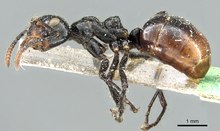| Dolichoderus sulcaticeps | |
|---|---|

| |
| Scientific classification | |
| Domain: | Eukaryota |
| Kingdom: | Animalia |
| Phylum: | Arthropoda |
| Class: | Insecta |
| Order: | Hymenoptera |
| Family: | Formicidae |
| Subfamily: | Dolichoderinae |
| Genus: | Dolichoderus |
| Species: | D. sulcaticeps |
| Binomial name | |
| Dolichoderus sulcaticeps (Mayr, 1870) | |
| Synonyms | |
| |
Dolichoderus sulcaticeps is a species of ant in the genus Dolichoderus. Described by Mayr in 1870, the species is endemic to Borneo, Indonesia, Malaysia, Thailand and Vietnam.
Description
Dolichoderus sulcaticeps is a largely black ant with a smooth, or slightly reticulated, shiny body surface; the tip and hindermost part of the gaster are often yellowish or reddish.
Ecology
This species forms large supercolonies with multiple queens. In Java, the nests are built on the ground or on rocks, but in other regions, such as peninsular Malaya and Singapore, large partial nests with many chambers are built in the treetops on the underside of leaves. Inside these, on the leaf surface, the ants tend scale insects and treehoppers as throphobionts; the hemipteran such sap from the leaves and the ants feed on the honeydew secreted. In other locations on the trees, carton structures, made of fibrous chewed plant material, are built to house the throphobionts. The ants actively collect their hemipterans guests, transporting them to the ant nests or to the protected free-feeding sites.
When alarmed, Dolichoderus sulcaticeps uses vibrations to communicate with other members of the colony. The vibrations are generated by a worker scraping its mandibles across the substrate and are interpreted by other worker ants according to their level of excitement; they either freeze, or they are emboldened to become more aggressive. Reproductives usually retreat into the safety of the nest.
References
- Mayr, G. 1870b. Neue Formiciden. Verh. K-K. Zool.-Bot. Ges. Wien 20: 939-996 (page 957, (diagnosis in key) worker described)
- "Dolichoderus sulcaticeps". AntWiki. Retrieved 21 May 2020.
- Rohe, Wolfgang; Maschwits, U. (2003). "Carton nest building and trophobiont manipulation in the south-east Asian ant Dolichoderus sulcaticeps (Mayr 1870) (Hymenoptera: Formicidae)". Journal of Natural History. 37 (23): 2835–2848. doi:10.1080/0022293021000007408.
- Rohe, Wolfgang; Rupprecht, R. (2001). "Knocking and scraping as alarm signals in Dolichoderinae ants from the Malay Peninsula (Hymenoptera: Formicidae: Dolichoderinae)". Entomologia Generalis. 25 (2): 81–96.
| Taxon identifiers | |
|---|---|
| Dolichoderus sulcaticeps | |